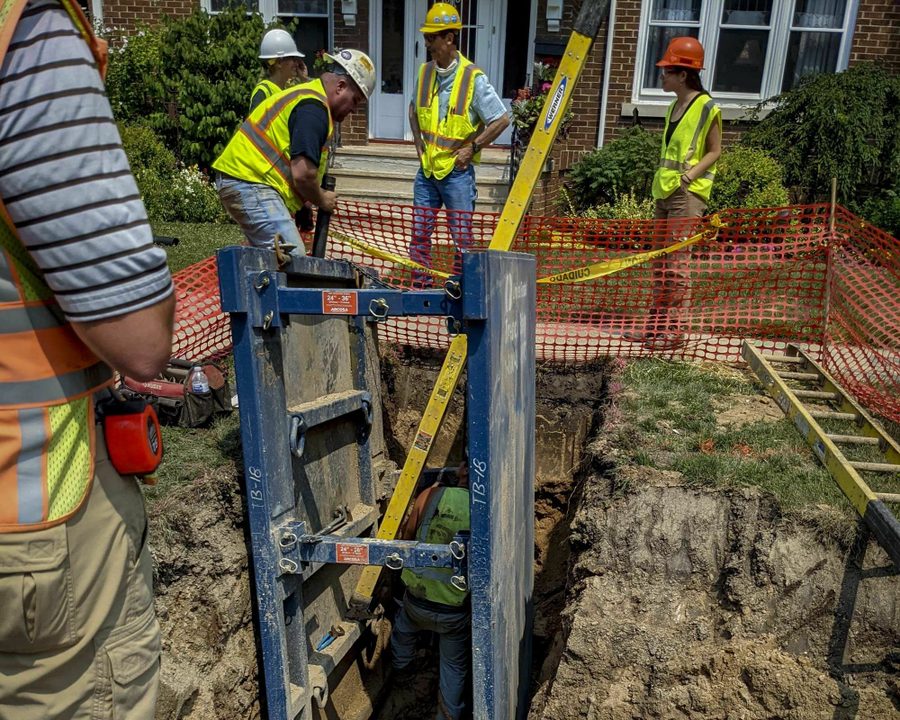A Lead Problem Worse Than Flint's
Hundreds of thousands of lead service lines in Wisconsin are a threat to public health, and communities of color are particularly vulnerable.
Susan Shain

MILWAUKEE — Shyquetta McElroy’s son put up a sign in their front yard to celebrate his middle school graduation in June. McElroy says she felt like the “proudest mom on the planet.” But her elation was bittersweet. McElroy thinks back on how emotionally and intellectually grueling it’s been for her son. He is 14 and reads at a second-grade level. He has dyslexia, difficulty retaining information and debilitating migraines and anxiety. These issues, McElroy says, are because of childhood lead poisoning.
Wisconsin tested roughly a quarter of its children under age six for lead poisoning in 2018; 6.6 percent had blood lead levels of at least five micrograms per deciliter (mcg/dL), over double the national average of 2.6 percent.
The problem is worse among Black children, like McElroy’s son. A 2016 report from the Wisconsin Department of Health Services found that, though Black children made up only 21 percent of children tested for lead poisoning, they accounted for half of all lead poisoning cases. In total, 13.2 percent of Black children tested had elevated lead levels, four times the rate of children with lead poisoning in Flint, Mich., that year.
When her son was born in 2006, McElroy took him to an appointment with the national low-income public health program Women, Infants, and Children (WIC). Nurses revealed that her son’s lead level was 5 mcg/dL, which was half the official “level of concern,” according to the Centers for Disease Control and Prevention (CDC). They gave her a pamphlet, but did not tell her to get a water filter or test her paint. As an 18-year-old, first-time mother, McElroy thought she and her son were safe.
It wasn’t until 2012 that the CDC updated its stance on lead. It now says 5 mcg/dL is poisonous and that no amount is “safe.” Early lead poisoning can damage the brain and delay development, causing issues in learning, behavior, hearing and speech, among others.
“There is no safe lead level,” says McElroy, who is now an organizer with the Coalition on Lead Emergency. “My son is living proof that, at even 5 mcg/dL, [lead] can have life-altering effects.”
The 2016 Wisconsin Department of Health Services report says kids from low-income families are most at risk “because they have limited options for selecting housing.”
In Milwaukee, more than 40 percent of water service lines are made of lead and more than 50 percent of households rent, which means they rely on their landlords to replace the pipes. Brenda Coley, co-executive director of the nonprofit Milwaukee Water Commons, says this is an environmental justice issue.
“Most of [Milwaukee’s] 70,000 lead laterals are in old housing stock, which are left in vulnerable communities — that would be people of color,” Coley says.
The Wisconsin Department of Natural Resources (DNR) says the state has at least 325,000 remaining lead service lines. By some estimates, this is more than any other state per capita. And the problem isn’t only in Milwaukee. “Dozens of other communities have tens of thousands of lead service lines that pose a public health risk,” says Scott Laeser, Water Program Director at environmental advocacy group Clean Wisconsin. “This is a statewide problem.”
Many rural Wisconsinites who rely on one of the state’s 800,000 private wells assume their water is clean, but lead contamination, Laeser warns, is something that every resident “should be doing their due diligence” to prevent. Laeser should know. He and his wife own a 19th-century farmhouse outside Argyle, a southwestern Wisconsin town with a population of roughly 900. When they decided to have children, they got their well tested and had to replace a small lead pipe. The cost was $1,200.
For most homeowners, the cost would be $3,000 – $5,000. Wisconsin does have several programs to help and is only the third state to let utility companies use ratepayer funds to assist homeowners in removing private-side lead pipes. In total, the DNR estimates it has distributed $38 million to cities assisting about 10,000 homeowners since 2017.
One such homeowner was Hannah Doudna, a resident of Stoughton, a city of 13,000 just south of Madison. In July 2020, while working on an adjacent street, contractors discovered a lead pipe on Doudna’s property.
When Doudna called Jill Weiss, utility director for the city of Stoughton, Weiss told her that because the pipe was on private property, Doudna was responsible for replacing it — at a cost of $27,000. That was an unimaginable sum to Doudna, a lab technician, and her boyfriend, a student who worked part time at Kwik Trip and Pick ‘n Save.
After repeated calling, Weiss eventually told her the city had learned about a DNR grant that might pay to replace Doudna’s pipes, as well as those of approximately 650 other Stoughton homeowners.
For the next nine months, Doudna anxiously waited to learn if Stoughton’s grant application had been approved. “It was a scary situation,” Doudna says. “If we would have had to pay for that $27,000, I had no idea where we were gonna get that money.” Eventually, the DNR funding did come through, and Doudna’s pipes were replaced in July 2021.
Other success stories include Madison, which was one of the first cities in the country to proactively replace all of its lead pipes, and Green Bay, which completed its five-year, $6 million replacement project last year.
Despite some regional successes, however, statewide progress has been slow. In Milwaukee, for example, fewer than 1,000 lead service lines are replaced annually. At that rate, removal will take 70 years and several generations of vulnerable children.
Activists point to a myriad of reasons for Milwaukee’s sluggish pace. One is frequent turnover in the scandal-plagued city health department. Another is a lack of political will.
“The narrative that has come out of the city of Milwaukee has been that the amount of lead poisoning that happens from lead in water is minuscule,” says Robert Penner, a member of Get the Lead Out Coalition of Milwaukee. “It’s a mechanism they’re using to try to not have to pay out for a very quick lead lateral replacement.”
In an email to In These Times, Emily Tau, marketing and communications officer at the Milwaukee Health Department, says that while “all sources of lead poisoning need to [be] removed from the city,” lead paint is the department’s “priority.” Tau cites two 2019 reports stating that most childhood lead exposure in Wisconsin results from lead-based paint and its dust.
Penner, however, says geographic information system mapping from his organization suggests otherwise: that most of Milwaukee’s lead poisoning cases result from a combination of contaminated water and paint.
Either way, Milwaukee’s most formidable roadblock is the $800 million it would cost to replace its lead pipes. In 2021, the city budget allocated just $5.5 million to private-side LSL replacement.
“What the city needs to do is it needs to accept help where it can from the state government and from the federal government,” Penner says.
The American Jobs Plan initially allocated $45 billion to replace lead pipes nationwide but was reduced to $15 billion — which experts say is too little. Attempts to increase state aid have also failed; in 2019 and 2021, Wisconsin’s Republican-majority legislature rejected plans for $40 million in additional funding. Even if money weren’t an issue, Steve Elmore of the Wisconsin DNR says that replacing the pipes would be at least a decade-long project in Milwaukee alone, because of the lack of workers.
Meanwhile, heading to his first high school football practice, McElroy’s son had another anxiety attack. In the parking lot, he said to his mother, “I don’t think I’m brave enough to go through this for another four years.”
“He’s exhausted,” McElroy says. “He has to push himself 10 times harder than the average student.” Just keeping him in school is her top priority, she adds, pointing to studies that correlate lead exposure with juvenile delinquency. “The worst thing for a parent is something happening to your children,” she says. “And I’m still living that fear.”
Susan Shain is a freelance journalist based in Madison, Wis.





